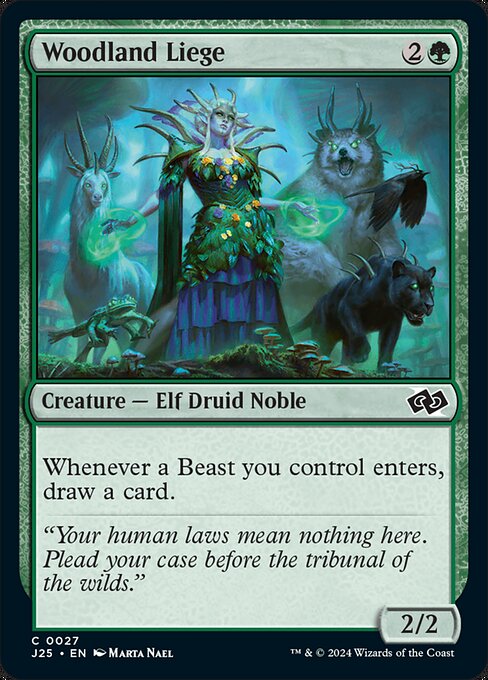
Image courtesy of Scryfall.com
Beast Enter Triggers and the Woodland Liege Math
If you’ve ever seasoned a green-to-the-core EDH game with a dash of card draw, Woodland Liege is a charming little puzzle box 🧙♂️. This common Elf Druid Noble from Foundations Jumpstart (j25) costs {2}{G} and sports a modest 2/2 profile, but its true value lives in its trigger: “Whenever a Beast you control enters, draw a card.” That means every Beast that slips onto the battlefield under your control demands you replace it with another card, one-for-one, in the most literal sense ⚔️. The effect scales with what’s entering—tokens, large splashy beasts, or a flurry of chump-blockers—and it rewards you for stacking multiple entries in a single moment or across several turns. It’s a reminder that in MTG, flavor and function can be inseparable, especially when you’re trying to outpace an opponent with a steady stream of gas through creature population growth 🎨.
At first glance, you might think a single Beast entering equals a single extra draw; fair enough. But Woodland Liege’s true power reveals itself when Beasts enter in batches. In MTG, multiple creatures entering the battlefield at the same time each count as individual events for ETB triggers. If you flash in two Beasts with a single spell or token generator, you don’t get one draw—you get two draws. If a board wipe re-fills the battlefield with Beasts, you could chain several draws back-to-back. The odds aren’t about luck of drawing a particular card from your deck in that instant; they’re about the predictable math of how many times you’ll get to draw in a given sequence of Beasts entering. The result is a creative blend of tempo and resilience 🧙♂️🔥.
The core idea: counting triggers, not guessing draws
- Triggers scale with Beasts entering: Each Beast entering your battlefield triggers woodland Liege once, drawing a card. If three Beasts enter at once, that’s three draws. If Beasts enter over several steps, each event adds to the total draw count.
- Tokens count too: Don’t forget tokens you control count as Beasts if they have that creature type. A token swarm that enters the battlefield can pump your card draw as long as those tokens are Beasts.
- Beast-rich decks shine: Decks that lean into Beast production—whether through collaborative synergy, token strategies, or mass-enter effects—amplify Woodland Liege’s value. You’re chasing a chain of “enter, draw, enter, draw” that can swing the momentum dramatically 🔥.
To translate this into probability terms, you can treat each Beasts-enter event as a discrete trigger. If you’re wondering “what are the odds I’ll see a particular payoff card after a sequence of draws?”, you model it as drawing from a deck with a given number of success cards. A clean, practical approach uses the hypergeometric distribution (draws without replacement). For a deck of N cards with X copies of a chosen target (say, a critical cantrip or finisher), drawing k cards yields:
Probability of drawing at least one target after k draws = 1 - C(N − X, k) / C(N, k)
For example, with N = 60, X = 4, and k = 2 draws (perhaps two Beasts entered over two turns or two Beasts entering together), the probability is 1 − C(56, 2) / C(60, 2) ≈ 1 − 3080/3540 ≈ 0.13, or about 13%. With k = 3, it climbs to roughly 19%. The more Beasts you reliably coax into play, the more draws you generate, and the more likely you are to hit your key cards in the deck’s mid-to-late game. It’s not about luck per se; it’s about aligning your board state with predictable search space growth 🌱🔍.
Practical scenarios and play-patterns
- One Beast enters on turn one → one draw, straightforward tempo boost. If you’re playing a mono-green shell, this can help you hit land drops or a second threat sooner than expected 🧙♂️.
- Two Beasts enter in a single spell or token-fect → two draws. This is where Liege begins to look like a mini-Gaea’s Cradle for card advantage in the right circle of synergy.
- Beasts enter over multiple turns → cumulative draws. The power curve comes from continuous pressure. Each new Beast adds a fresh card to your hand, keeping your engine humming and your threats growing ⚔️.
- Board wipes that refill with Beasts → a potential cascade of draws. If your deck allows quick recursion or replays, Woodland Liege can sustain a surprising number of cards despite costly tempo hits.
Design-wise, the card’s rarity (common) and the Foundations Jumpstart set framing emphasize accessible, all-ages strategy. The flavor text—“Your human laws mean nothing here. Plead your case before the tribunal of the wilds.”—is a cheeky nod to a larger ecosystem where the forest calls the shots, not the courtroom. The art by Marta Nael, with its vivid greens and regal stance, reinforces the idea that woodland guardianship is both elegant and formidable 🖼️.
Deckbuilding takeaways and a nod to artful play
If you want Woodland Liege to shine, lean into Beast production, but don’t overcommit to filler Beasts that don’t push card advantage. Seek Beasts that enter with value, or support Beasts that help you ramp, fetch, or untap. The card’s true value lies in the reliable cadence of draws emitted each time a Beast arrives. The result is a green engine that rewards careful timing and careful hand management—elements every MTG player cherishes 🧩.
On a lighter note, the fusion of probability and mythic storytelling is part of what makes MTG such a shared hobby. You can practically hear the forest whispering about odds, while your board states ride the rollercoaster of chance and planning. It’s the kind of dynamic that keeps a table smiling, arguing, and swapping tales about the moment a single Beast triggers a cascade of draws—and a comeback from defeat 💎.
Clear Silicone Phone Case (Slim, Flexible Protection)More from our network
- https://blog.digital-vault.xyz/blog/post/clone-shell-limited-editions-print-scarcity-and-collector-buzz/
- https://blog.zero-static.xyz/blog/post/mindswipe-lore-mirrors-real-world-legends-in-mtg/
- https://crypto-acolytes.xyz/blog/post/how-virtual-banking-and-lending-transform-in-game-economies/
- https://transparent-paper.shop/blog/post/cross-matching-a-distant-hot-giant-at-four-kiloparsecs-with-spectroscopy/
- https://blog.digital-vault.xyz/blog/post/mulligan-timing-for-deadshot-minotaur-in-aggro-decks/